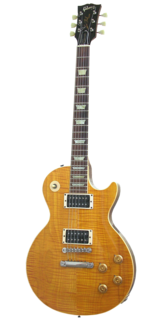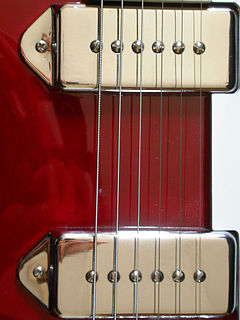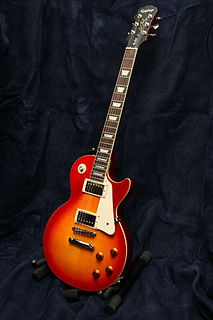
An electric guitar is a guitar that requires external amplification in order to be heard at typical performance volumes, unlike a standard acoustic guitar. It uses one or more pickups to convert the vibration of its strings into electrical signals, which ultimately are reproduced as sound by loudspeakers. The sound is sometimes shaped or electronically altered to achieve different timbres or tonal qualities on the amplifier settings or the knobs on the guitar from that of an acoustic guitar. Often, this is done through the use of effects such as reverb, distortion and "overdrive"; the latter is considered to be a key element of electric blues guitar music and rock guitar playing.

The Gibson SG is a solid-body electric guitar model introduced by Gibson in 1961 as the Gibson Les Paul SG. It remains in production today in many variations of the initial design. The SG Standard is Gibson's best-selling model of all time.

The Gibson Les Paul is a solid body electric guitar that was first sold by the Gibson Guitar Corporation in 1952. The guitar was designed by factory manager John Huis and his team with input from and endorsement by guitarist Les Paul. Its typical design features a solid mahogany body with a carved maple top and a single cutaway, a mahogany set-in neck with a rosewood fretboard, two pickups with independent volume and tone controls, and a stoptail bridge, although variants exist.

Epiphone is an American musical instrument brand that traces its roots to a musical instrument manufacturing business founded in 1873 by Anastasios Stathopoulos in Smyrna, Ottoman Empire and moved to New York City in 1908. After taking over his father's business, Epaminondas Stathopoulos named the company "Epiphone" as a combination of his own nickname "Epi" and the suffix "-phone" in 1928, the same year it began making guitars.

The Gibson ES-335 is the world's first commercial semi-hollowbody electric guitar, sometimes known as semi-acoustic. Released by the Gibson Guitar Corporation as part of its ES series in 1958, it is neither fully hollow nor fully solid; instead, a solid maple wood block runs through the center of its body. The side "wings" formed by the two "cutaways" into its upper bouts are hollow, and the top has two violin-style f-holes over the hollow chambers. Since its release, Gibson has released numerous variations of and other models based on the design of the ES-335.

Paul Reed Smith Guitars, also known as PRS Guitars, is an American guitar and amplifier manufacturer located in Stevensville, Maryland. The company was founded in 1985 in Annapolis, Maryland by Paul Reed Smith.

The P-90 is a single coil electric guitar pickup produced by Gibson since 1946. Gibson is still producing P-90s, and there are outside companies that manufacture replacement versions. Compared to other single coil designs, such as the ubiquitous Fender single coil, the bobbin for a P-90 is wider but shorter. The Fender style single coil is wound in a taller bobbin but the wires are closer to the individual poles. This makes the P-90 produce a different type of tone, somewhat warmer with less edge and brightness. As with other single-coil pickups, the P-90 is subject to mains hum unless some form of hum cancelling is used.

The Gibson ES-175 is an electric guitar manufactured by the Gibson Guitar Corporation. It was dropped from the Gibson lineup for 2019 after 68 years in continuous production. It is a 243⁄4" scale full hollow-body guitar with a trapeze tailpiece and Tune-O-Matic bridge. It is one of the most famous jazz guitars in history.

The Epiphone Casino is a thinline hollow body electric guitar manufactured by Epiphone, a branch of Gibson. The guitar debuted in 1961 and has been associated with such guitarists as Howlin' Wolf, George Harrison, John Lennon, Paul McCartney, Keith Richards, Dave Davies, Paul Weller, The Edge, Josh Homme, Daniel Kessler, Noel Gallagher, Brendon Urie, Gary Clark, Jr., Glenn Frey, John Illsley, Peter Green and Dave Grohl.

The Univox Hi-Flier is an electric guitar marketed and sold by Univox from roughly 1967 to 1977. With its reversed offset body, the Hi-Flier has an intentional resemblance to the Mosrite "Ventures" guitar. The name is often misspelled.
Matsumoku Industrial was a Japanese manufacturing company based in Matsumoto, Nagano, between 1951 and 1987. Established in 1951 as a woodworking and cabinetry firm, Matsumoku is remembered as a manufacturer of guitars and bass guitars, including some Epiphone and Aria guitars.

Greco is a Japanese guitar brand owned by the Kanda Shokai Corporation (in Japanese) 神田商会, a musical instrument wholesaler mostly known for being part of Fender Japan. Instruments manufactured with the name "Greco" are electric and acoustic guitars.

The Gibson Nighthawk was a family of electric guitars manufactured by Gibson. Introduced in 1993, the Nighthawk represented a radical change from traditional Gibson designs. While its maple-capped mahogany body and set neck were reminiscent of the classic Gibson Les Paul, the Nighthawk incorporated a number of characteristics more commonly associated with Fender guitars. The Nighthawk was not a commercial success; production of all models was discontinued in 1998 after only five years.
The Fender Bullet was an electric guitar originally designed by John Page and manufactured and marketed by the Fender Musical Instruments Corporation. It was first introduced as a line of "student" guitars to replace the outgoing Mustang and Musicmaster models.
The Epiphone Sheraton is a thinline semi-hollow body electric guitar. Though the Sheraton and all its variations were introduced under the ownership of the Gibson Guitar Corporation, Epiphone is the exclusive manufacturer.

The Epiphone Les Paul is a solid body guitar line produced by Epiphone as a more modestly priced version of the famous Gibson Les Paul. Epiphone is a subsidiary of Gibson Guitar Corporation and manufactures the Les Paul model and other budget models at a lower cost in Asia.

A Univox Coily is a hollow body electric guitar manufactured by Matsumoku and sold under the Univox brand. It is nearly identical to the Epiphone EA-250 guitar also made by Matsumoku. The guitar featured two pickups, a floating roller bridge, and a Bigsby-style tailpiece.
The Vox Custom 24 was one of a group of guitars produced in Japan by the Matsumoku company between 1980–85, which included the Custom and Standard 24 and Custom and Standard 25 guitars. Custom and Standard bass guitars were also included in the range. Matsumoku had already produced guitars for Aria and other brands such as Westbury. These were recognised as leaders in performance, innovation and quality. The electronics in these guitars were designed by Adrian Legg. The guitars are passive but the complex switching allows for a wide variety of sounds, making them extremely versatile instruments.
The Yamaha Corporation is a multinational corporation and conglomerate based in Japan with a wide range of products and services, predominantly musical instruments, motorcycles, power sports equipment and electronics.
The Epiphone Rivoli was a semi-hollowbody electric bass guitar designed by Gibson and built by Epiphone in Kalamazoo, Michigan from 1959 until 1970. From 1993 until 1999, the model was reissued as a part of the Korean-Japanese Epiphone line.














